Dynamic Compression Properties of Ni-Fe Slag Powder Soil Cement under Impact Load
Abstract
:1. Introduction
2. Test Materials and Scheme
2.1. Test Materials
2.2. Test Scheme
2.2.1. Test Design
2.2.2. Test Instrument and Procedure
- (1)
- Fully apply petroleum jelly on the front and back sides of the specimen that has been cured to age;
- (2)
- Clamp the specimen between the incident bar and the transmission bar to make the specimen face in full contact with the bar;
- (3)
- Apply petroleum jelly on the contact surface between the incident bar and the impact bar and affix the strain gauge;
- (4)
- Turn on the data acquisition device;
- (5)
- Set the air pressure to 0.25 MPa and open the air valve so that the air pressure pushes the impact bar to move at high speed, hit the incident bar and push it to hit the specimen;
- (6)
- Collect the incident wave, transmitted wave and reflected wave post-processing data through a data acquisition device;
- (7)
- Collect specimen fragments, take photos and perform termination hydration;
3. Results and Analysis
3.1. Impact Compression Test Results
3.2. Analysis of the Stress-Strain Curve
3.2.1. Effect of Admixture Ratio on the Soil Cement Dynamic Stress
3.2.2. Effect of Age on Soil Cement Dynamic Stress
4. SEM Test
4.1. Principle of the SEM Test
4.2. Analysis of SEM Test Results
5. Conclusions
Author Contributions
Funding
Institutional Review Board Statement
Informed Consent Statement
Data Availability Statement
Conflicts of Interest
References
- Wu, Y.; Hu, R.; Zhao, W.; Li, J. Experimental study on strength properties of silty cement solidified by steel slag powder. Sci. Technol. Eng. 2017, 17, 306–311. [Google Scholar]
- Cheng, Q.; Xiao, H.; Liu, Y.; Wang, W.; Jia, L. Primary yielding locus of cement-stabilized marine clay and its applications. Mar. Georesources Geotechnol. 2019, 37, 488–505. [Google Scholar] [CrossRef]
- Chen, F.; Tong, S. Experimental study on the strength of soil-cement with additions of mineral powder and ferronickel slag powder. Int. J. Min. Miner. Eng. 2020, 11, 218–227. [Google Scholar] [CrossRef]
- Liu, C.; Starcher, R.D. Effects of Curing Conditions on Unconfined Compressive Strength of Cement-and Cement-Fiber-Improved Soft Soils. J. Mater. Civ. Eng. 2012, 25, 1134–1141. [Google Scholar] [CrossRef]
- Bruce, D.A. An introduction to the deep soil mixing methods as used in geotechnical applications. Eur. J. Org. Chem. 2000, 578, 94–100. [Google Scholar]
- Manita, D.; Ashim, K.D. Use of soil-cement bed to improve bearing capacity of stone columns. Int. J. Geomech. 2020, 20, 6020008. [Google Scholar]
- Ma, Q.; Gao, C. Energy absorption and fractal characteristics of basalt fiber cement soil under impact load. Rock Soil Mech. 2018, 39, 3921–3928. [Google Scholar]
- Wang, J.; Zheng, X.; Cai, Y.; Guo, L. Dynamic and static characteristics test of cement-soil under strain control. J. Zhejiang Univ. (Eng. Sci.) 2010, 44, 1857–1862. [Google Scholar]
- Jamshidi, R.J.; Lake, C.B.; Barnes, C.L. Examining Freeze/Thaw Cycling and Its Impact on the Hydraulic Performance of Cement-Treated Silty Sand. J. Cold Reg. Eng. 2014, 29, 04014014. [Google Scholar] [CrossRef]
- Consoli, N.C.; Zortea, F.; de Souza, M.; Festugato, L. Studies on the dosage of fiber-reinforced cemented Soils. J. Mater. Civ. Eng. 2012, 23, 1624–1632. [Google Scholar] [CrossRef]
- Wu, X.; Wang, H.; Shen, X.; Xue, Z. Experimental study on engineering characteristics of silty clay improved by cement based on static triaxial test. Chin. Sci. Technol. Pap. 2015, 10, 1583–1587. [Google Scholar]
- Wang, J.; Ding, G.; Pan, L.; Cai, Y.-Q. Study on mechanical properties and constitutive model of cement-soil in static triaxial test. Rock Soil Mech. 2010, 31, 1407–1412. [Google Scholar]
- Chen, S.; Hou, R.; Ni, C.; Wang, J. Research on mechanical properties of cement soil based on triaxial compression tests. Bull. Silic. 2018, 37, 4012–4017. [Google Scholar]
- Pongsivasathit, S.; Horpibulsuk, S.; Piyaphipat, S. Assessment of mechanical properties of cement stabilized soils. Case Stud. Constr. Mater. 2019, 11, e0031. [Google Scholar] [CrossRef]
- Kolias, S.; Kasselouri-Rigopoulou, V.; Karahalios, A. Stabilisation of clayey soils with high calcium fly ash and cement. Cem. Concr. Compos. 2005, 27, 301–303. [Google Scholar] [CrossRef]
- Ismail, M.A.; Joer, H.A.; Sim, W.H.; Randolph, M.F. Effect of Cement Type on Shear Behavior of Cemented Calcareous Soil. J. Geotech. Geoenviron. Eng. 2002, 128, 520–529. [Google Scholar] [CrossRef]
- Chen, F.; Tong, S. Impermeability Characteristics of Treated Marine Soft Soil with Ferronickel Slag Powder. Geofluids 2022, 2022, 141056. [Google Scholar] [CrossRef]
- Chen, F. Experimental study on the influence of nickel-iron slag powder on the strength of cement soil. Silic. Bull. 2018, 37, 3113–3118. [Google Scholar]
- Chen, J. Experimental study on the solidification mechanism of nickel-iron slag powder cement soil. J. Hydraul. Archit. Eng. 2020, 18, 122–127. [Google Scholar]
- Chen, F.; Tong, S. Strength deterioration of composite nickel-iron slag powder cement soil in marine environment. J. Hydropower Gener. 2020, 39, 102–109. [Google Scholar]
- Chen, F. Test Research on the Strength of Ni-Fe Slag Powder Soil-cement at Early-ages. In Proceedings of the IOP Conference Series: Materials Science and Engineering, Paris, France, 23–25 July 2019. [Google Scholar]
- Chen, F.; Tong, S. Effect of Ferronickel Slag Powder on Strength of Soil in Marine Environment. Adv. Civ. Eng. 2020, 2020, 1410560. [Google Scholar] [CrossRef]

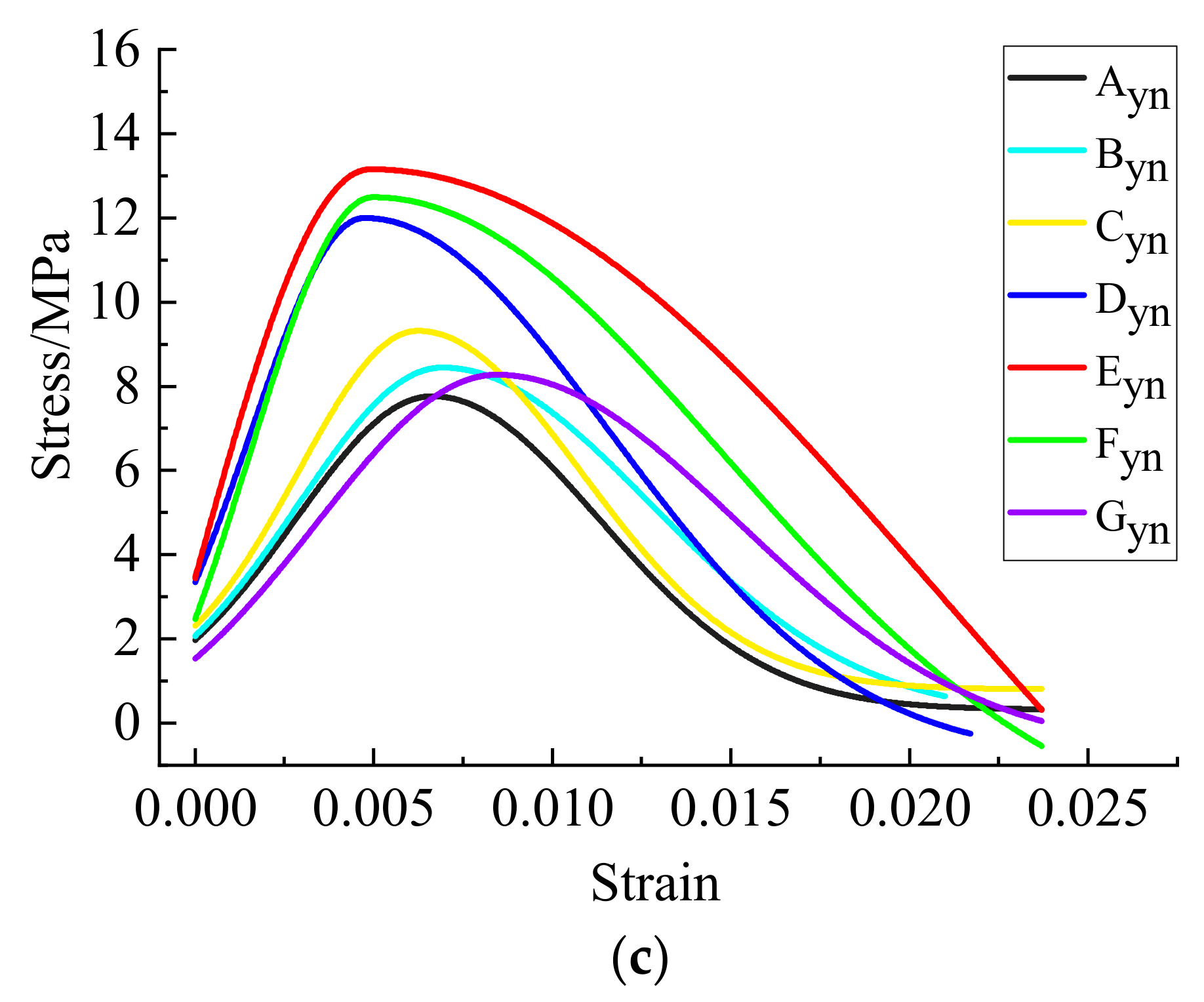
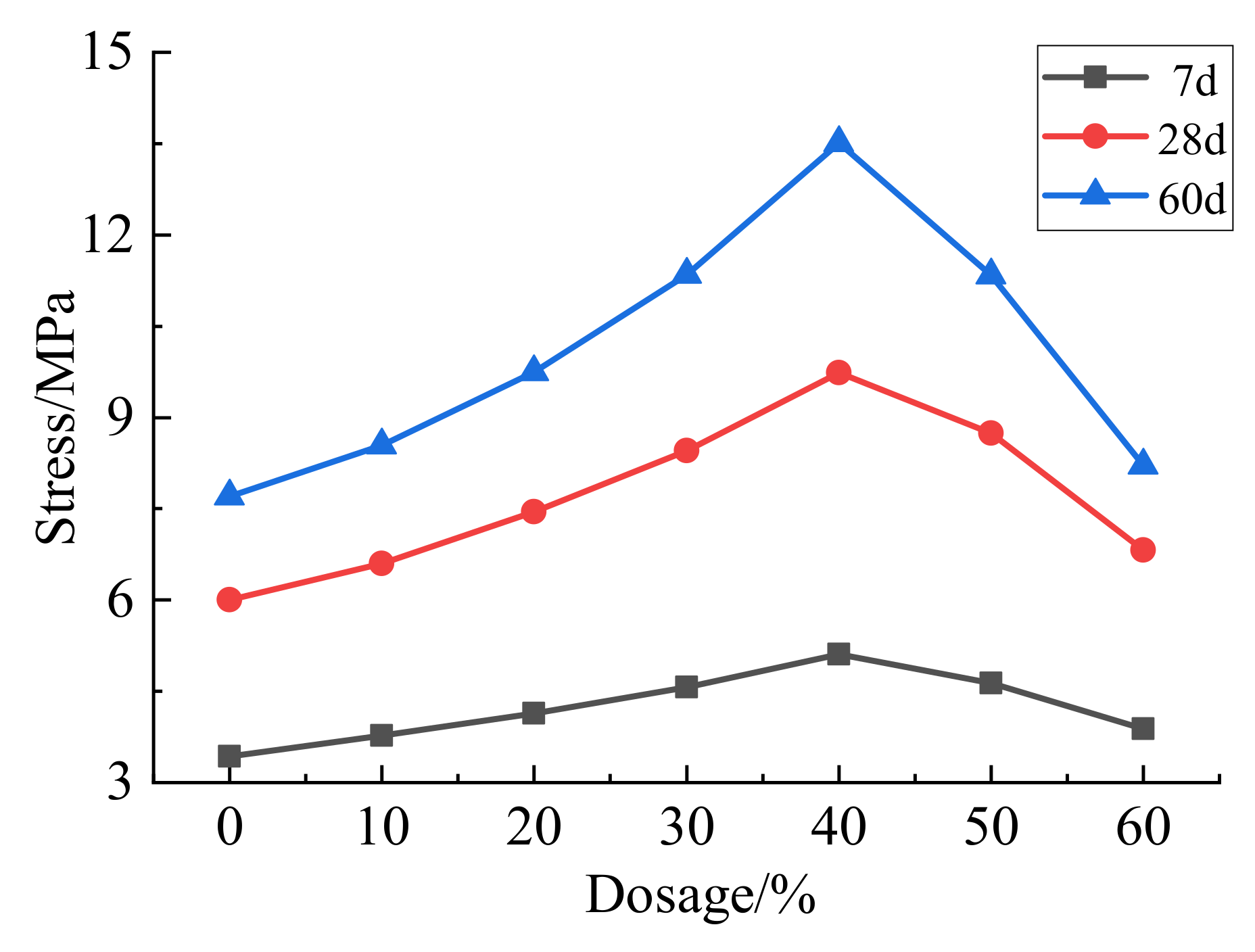
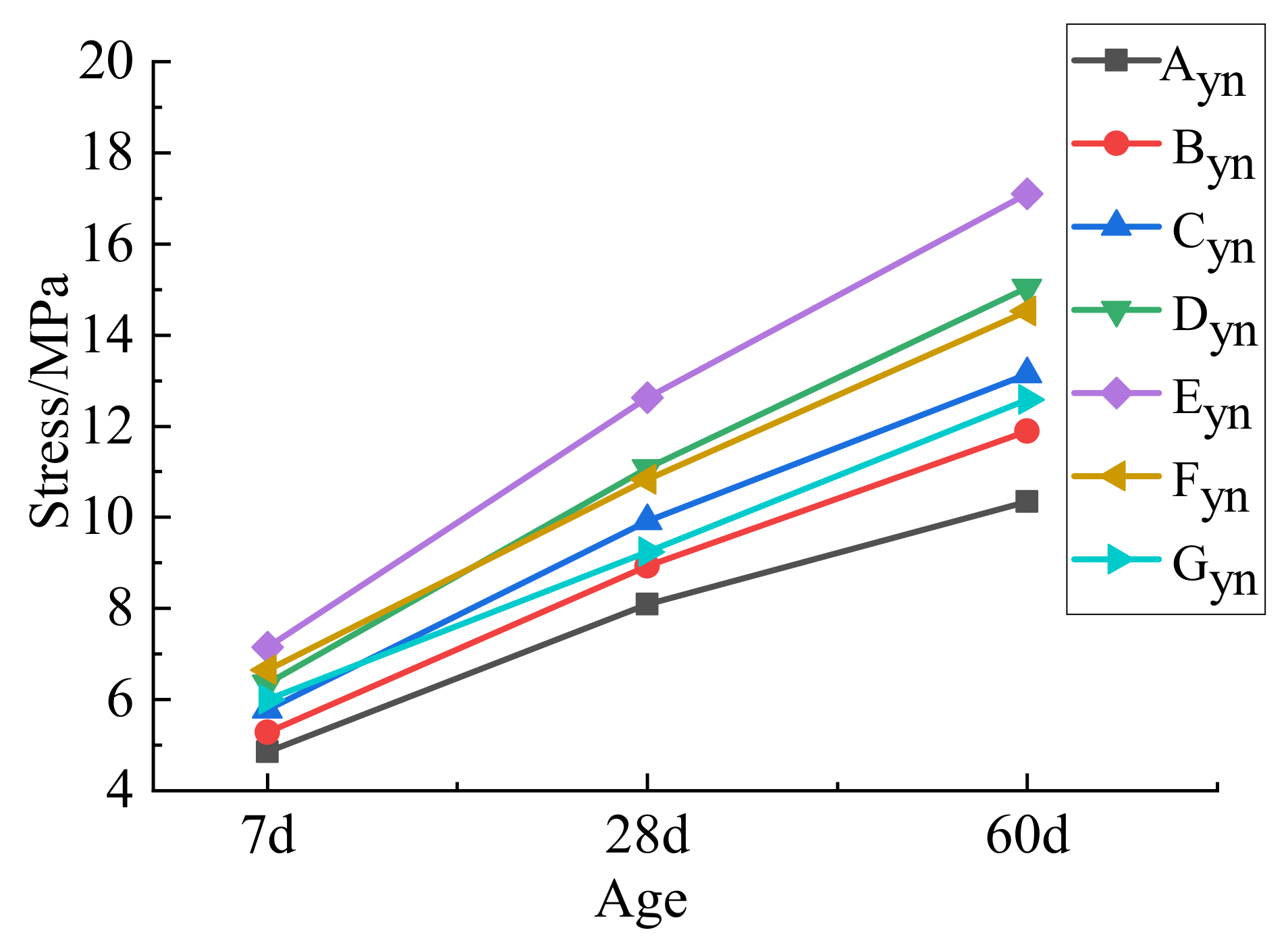
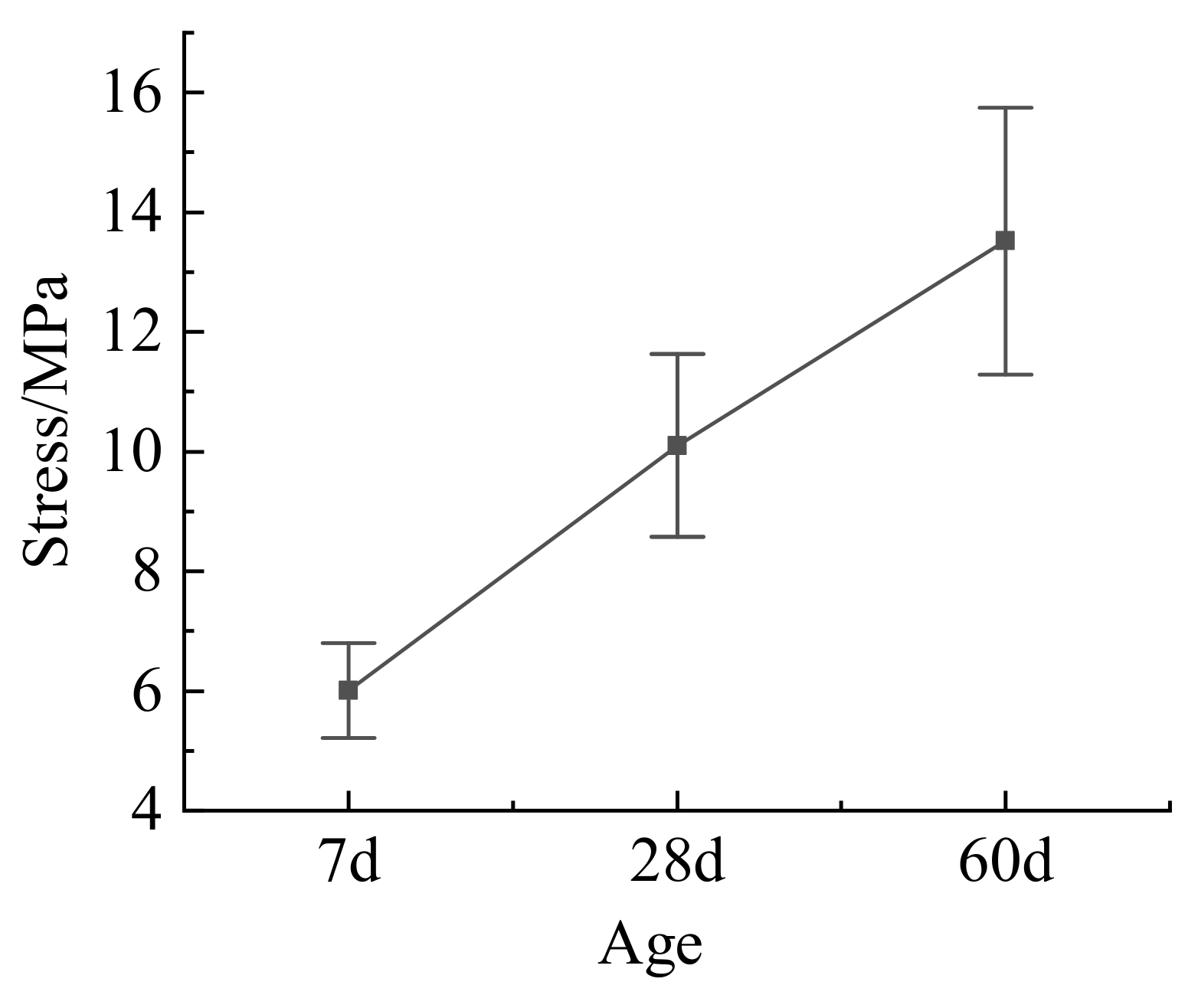
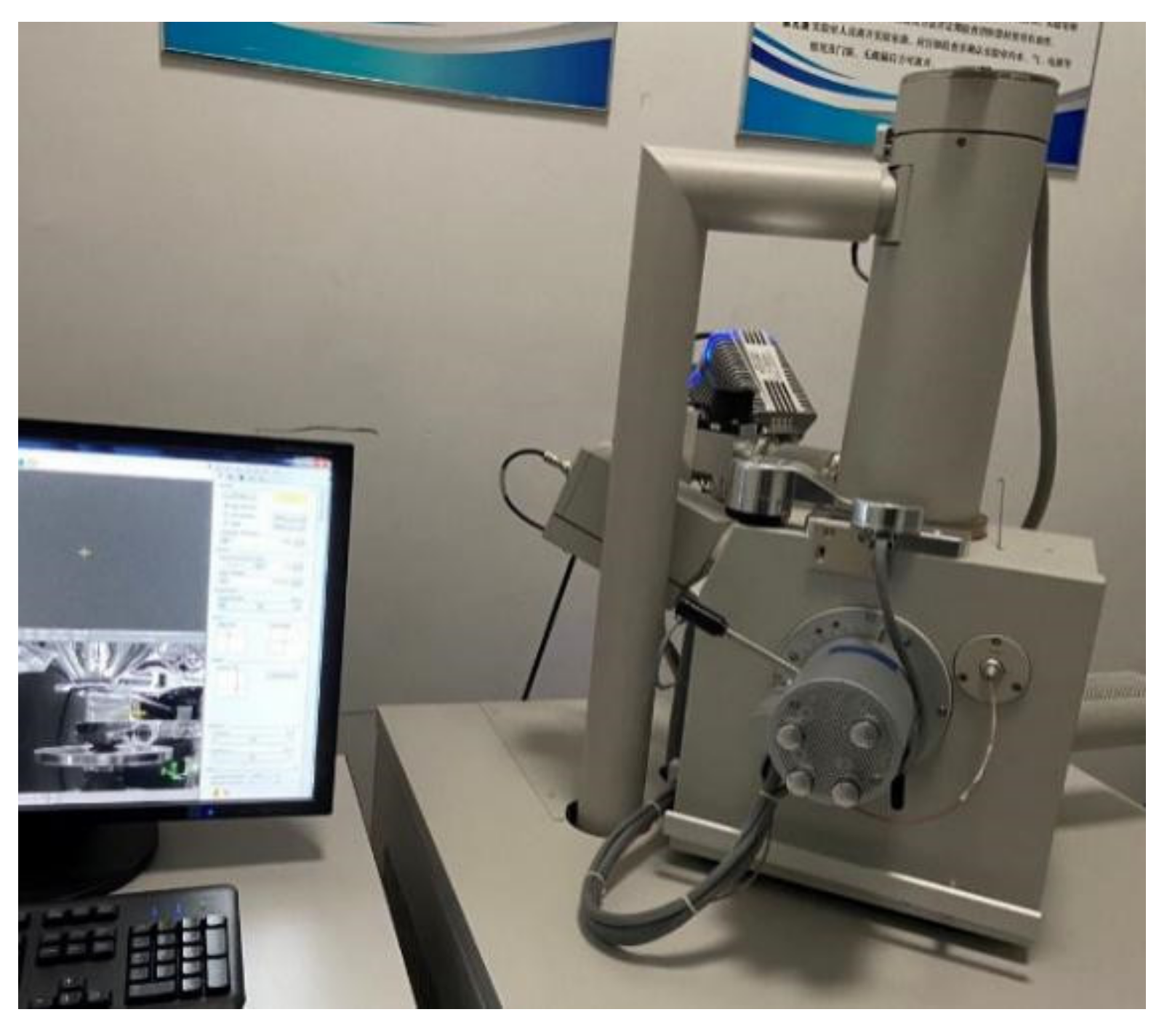
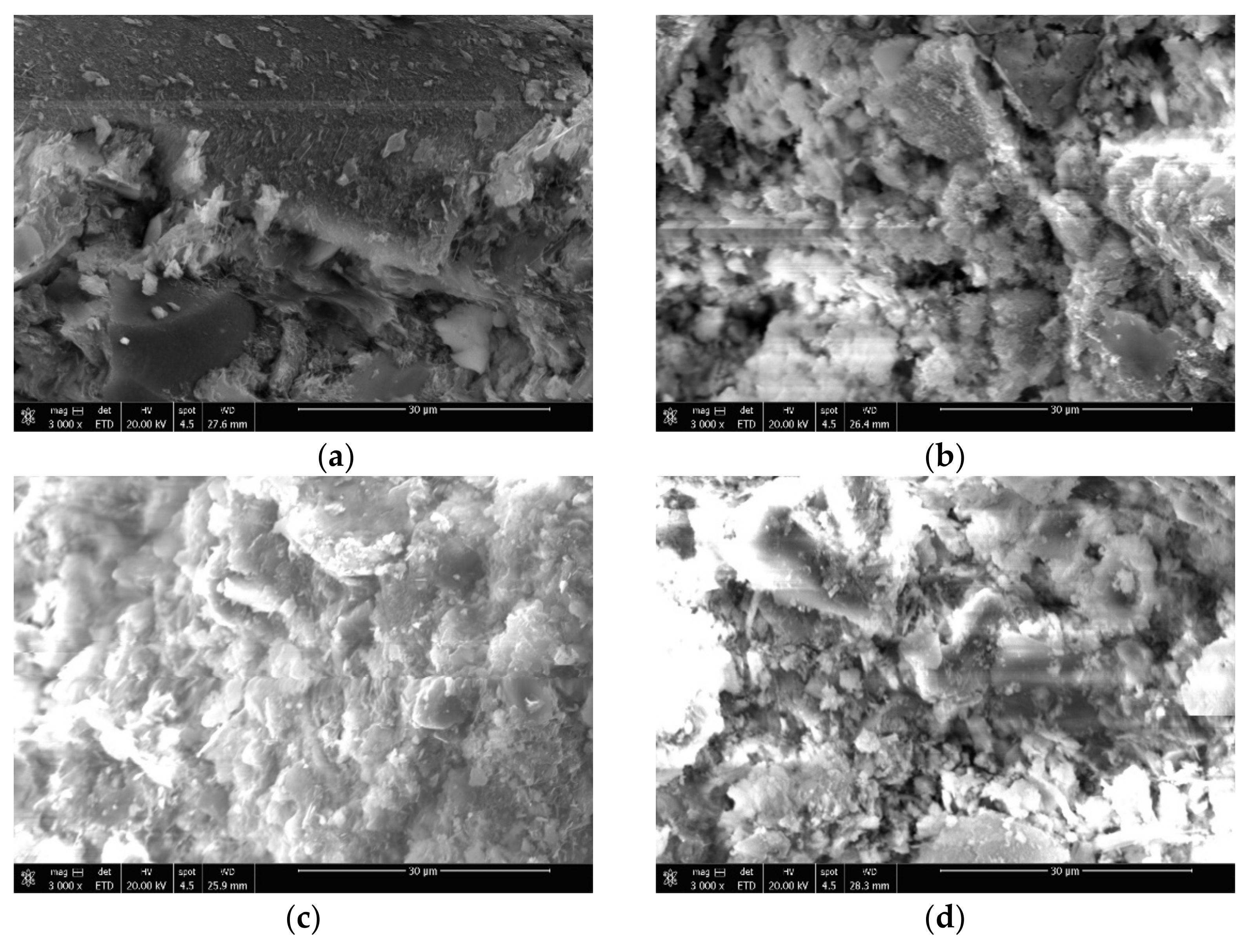
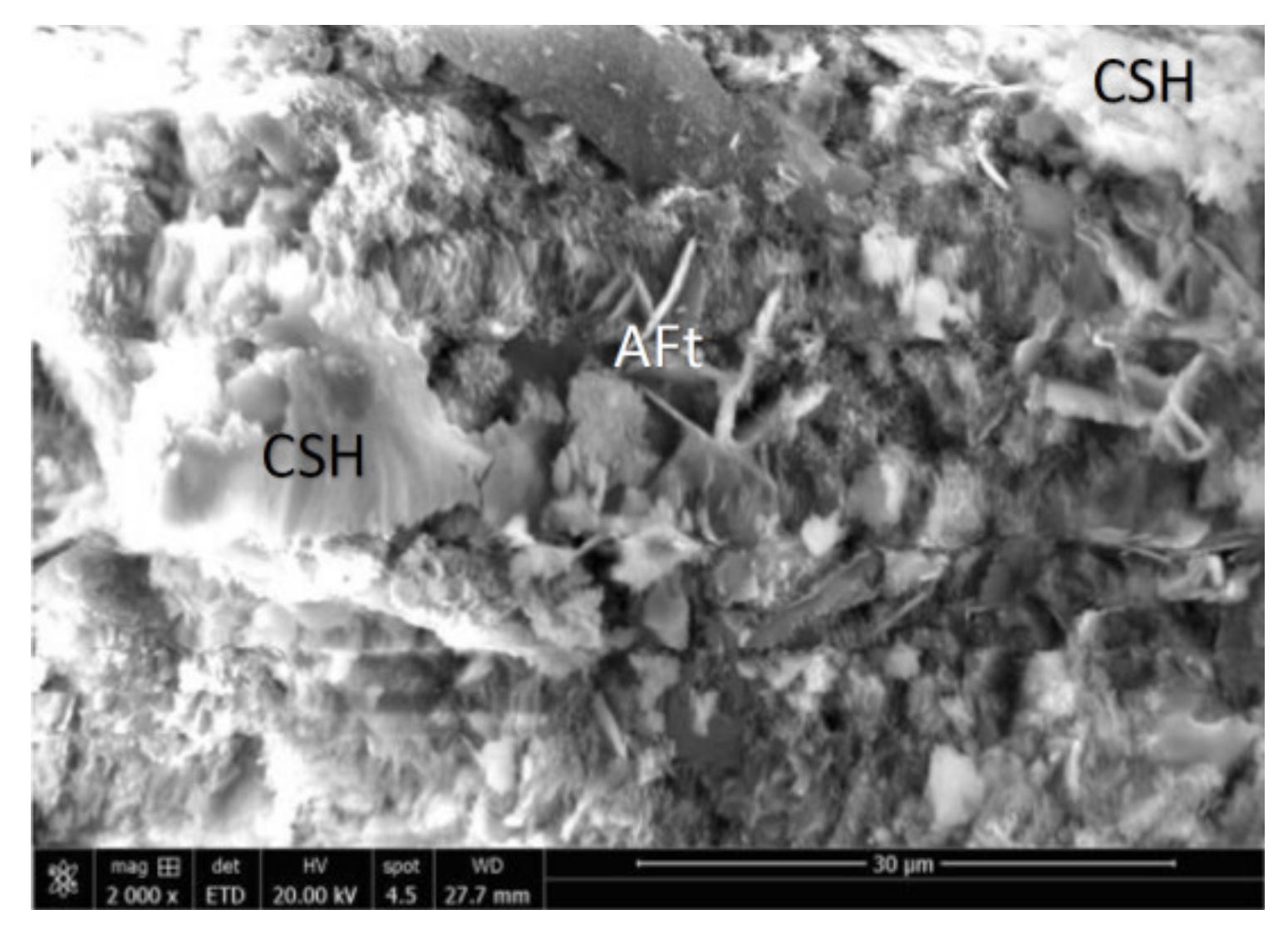
| Water Content w (%) | Weight R (kN/m3) | Void Ratio e | Liquid Limit WL (%) | Plastic Limit WP (%) | Plasticity Index IP | Liquidity Index IL |
|---|---|---|---|---|---|---|
| 58.5 | 15.67 | 1.729 | 53 | 28.7 | 21.53 | 1.61 |
| Composition | SiO2 | Al2O3 | CaO | MgO | TiO2 | MnO | Fe2O3 | SO3 | LOI |
|---|---|---|---|---|---|---|---|---|---|
| Ni-Fe Slag Powder (%) | 35.41 | 21.57 | 29.31 | 9.57 | 0.69 | 0.61 | 1.27 | 0.19 | 2.38 |
| Slag (%) | 32.11 | 16.79 | 36.07 | 10.62 | 0.96 | 0.81 | 2.31 | 0.18 | 0.19 |
| No. | Soil | Mixing Ratio-a (%) | Water-Cement Ratio | Mixing Ratio-b (%) | Quantity of Specimen (pcs.) | ||
|---|---|---|---|---|---|---|---|
| 7 d | 28 d | 60 d | |||||
| Ayn | silt | 15 | 0.5 | 0 | 3 | 3 | 3 |
| Byn | 10 | 3 | 3 | 3 | |||
| Cyn | 20 | 3 | 3 | 3 | |||
| Dyn | 30 | 3 | 3 | 3 | |||
| Eyn | 40 | 3 | 3 | 3 | |||
| Fyn | 50 | 3 | 3 | 3 | |||
| Gyn | 60 | 3 | 3 | 3 | |||
| Specimen | Peak Stress (MPa) | Peak Strain (10−3) | ||||
|---|---|---|---|---|---|---|
| No. | 7 d | 28 d | 60 d | 7 d | 28 d | 60 d |
| Ayn | 3.43 | 6.00 | 7.70 | 0.00995 | 0.0071 | 0.00649 |
| Byn | 3.77 | 6.60 | 8.54 | 0.00761 | 0.00717 | 0.00691 |
| Cyn | 4.14 | 7.45 | 9.74 | 0.00809 | 0.00623 | 0.00628 |
| Dyn | 4.57 | 8.45 | 11.35 | 0.00753 | 0.00672 | 0.00488 |
| Eyn | 5.10 | 9.73 | 13.51 | 0.00615 | 0.00559 | 0.00467 |
| Fyn | 4.64 | 8.74 | 11.33 | 0.00737 | 0.00578 | 0.00484 |
| Gyn | 3.89 | 6.82 | 8.21 | 0.00797 | 0.0085 | 0.00848 |
| Age | 7 d | 28 d | 60 d | |
|---|---|---|---|---|
| Growth Rate | ||||
| Ratio of Byn to Ayn | 9.89% | 9.99% | 10.89% | |
| Ratio of Cyn to Byn | 9.83% | 12.89% | 14.07% | |
| Ratio of Dyn to Cyn | 10.32% | 13.44% | 16.48% | |
| Ratio of Eyn to Dyn | 11.80% | 15.16% | 19.07% | |
| Ratio of Fyn to Eyn | −9.14% | −10.22% | −16.11% | |
| Ratio of Gyn to Fyn | −16.20% | −21.94% | −27.57% | |
| Age | 7 d to 28 d | 28 d to 60 d | |
|---|---|---|---|
| Admixture Ratio | |||
| Ayn | 74.95% | 28.36% | |
| Byn | 75.11% | 29.40% | |
| Cyn | 80.00% | 30.75% | |
| Dyn | 85.09% | 34.25% | |
| Eyn | 90.65% | 38.81% | |
| Fyn | 88.38% | 29.70% | |
| Gyn | 75.46% | 20.35% | |
Publisher’s Note: MDPI stays neutral with regard to jurisdictional claims in published maps and institutional affiliations. |
© 2022 by the authors. Licensee MDPI, Basel, Switzerland. This article is an open access article distributed under the terms and conditions of the Creative Commons Attribution (CC BY) license (https://creativecommons.org/licenses/by/4.0/).
Share and Cite
Chen, F.; Tong, S.; Hao, W.; Shen, S. Dynamic Compression Properties of Ni-Fe Slag Powder Soil Cement under Impact Load. Coatings 2022, 12, 1003. https://doi.org/10.3390/coatings12071003
Chen F, Tong S, Hao W, Shen S. Dynamic Compression Properties of Ni-Fe Slag Powder Soil Cement under Impact Load. Coatings. 2022; 12(7):1003. https://doi.org/10.3390/coatings12071003
Chicago/Turabian StyleChen, Feng, Shenghao Tong, Wang Hao, and Shilin Shen. 2022. "Dynamic Compression Properties of Ni-Fe Slag Powder Soil Cement under Impact Load" Coatings 12, no. 7: 1003. https://doi.org/10.3390/coatings12071003






